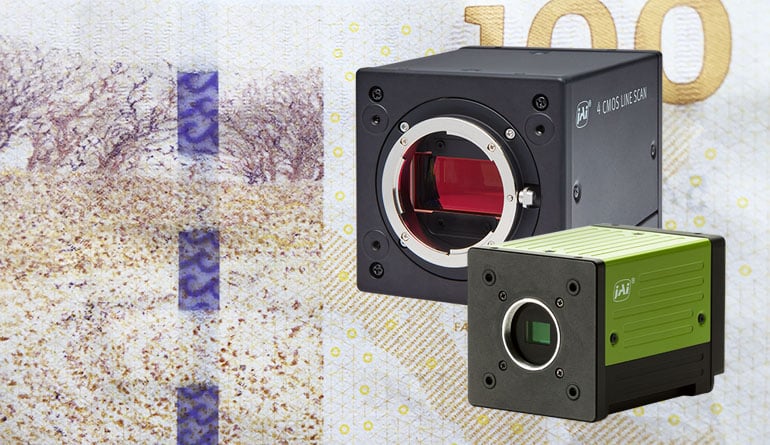
Over the last decades and especially recently, digital payment has become more and more popular. But the unique features of cash payment still have their advantages. Paying by cash is thought to be cheaper for small retail payments, does not exclude people with limited or no access to a bank account or electronic payment systems, and can easily be kept track of.
Download Tech Guide about multispectral imaging.
Watch Webinar about multispectral imaging
Bank notes are usually produced across several production sites. They must be of high quality to be retailed and trusted, as well as include complex security features to be counterfeit proof. A robust and highly sensitive control system that supports a wide range of features, as well as ensuring high quality and compliance across all production sites is needed. Automated visual inspection systems using multispectral cameras provide a solution for this.
According to the newest press release by the European Central Bank, around 558 thousand counterfeit euro (EUR) bank notes were detected and withdrawn in the second half of 2019. With around 24 billion notes in circulation, the percentage is extremely small. Introducing new and more sophisticated security features, the number of counterfeit bank notes has been steadily decreasing.
The Swiss franc (CHF) is considered among the toughest to counterfeit. Less than 1000 counterfeited bank notes with a total worth of 220 thousand CHF have been reported in 2019. The U.S. dollar (USD), on the other hand, is one of the most counterfeited currencies in the world, mostly because it is distributed and used all over the globe, while having relatively low security standards.
Bank notes incorporate several security features. Special printing techniques on cotton-fibre paper make them wear resistant and give them a unique feel. Raised ink on the edges indicates the specific bank note for visually-impaired people, and the intaglio printing technique is of extremely high resolution. Line structures printed in micro scale are only visible with magnifying glasses.
When looking at the bank note against the light, watermarks and portrait windows become visible and special light effects on the bank note are revealed when the note is tilted. More sophisticated features such as micro printing, standard and special UV and IR properties can be checked using special devices. Swiss francs include even further security features such as embedded copper printing and micro hole patterns. Those security features distinguish real notes from counterfeit ones.
However, they must also be verified along with other quality features of the bank note at the production site. Currently, hundreds of automatic and manual monitoring actions are needed to assure the correctness and quality of bank a note and its security features.
Automated visual inspection methods can verify most of the features. Each bank note has a unique serial number encoding its origin, a feature that can easily be checked with a conventional RGB camera. RGB cameras can furthermore inspect color, size, printing quality and labelling. Common RGB cameras however will not allow for inspection of additional security properties in the UV and near-IR region. That is where multispectral cameras come into play.
Multispectral cameras capture information of multiple discretely positioned spectral bands, including bands beyond the visible range. Thus, using multispectral cameras, a single setup can be used to validate and verify visible quality and security features such as shape, color, and labelling, as well as non-visible features such as the near-IR properties. Using a single device for quality inspection makes the setup generally more effective, robust, and cost-efficient. It is therefore also suitable for use across different production sites.
Prism-based multi-sensor cameras have a prism block which acts as multiple filters, redirecting the appropriate spectral ranges to each one of its sensors. A prism-based multi-spectral camera operating in a multispectral capacity will be able to check a wide range of security features. Using a high-resolution camera and the right optics, the system will also be able to inspect micro-printing.
For quality assessment as well as defect detection, characteristics seen through different spectral bands can be compared. Correlation of those characteristic help to accurately identify position and size of defects. Using a camera system with a single optical axis offers highly precise alignment of various spectral bands, and thus improves the effectiveness of the inspection.
The number of spectral bands and their range must be chosen carefully. Some types of multispectral cameras feature a high number of spectral bands to ensure coverage. But the excess number of wavebands greatly limit the speed at which a detailed image can be obtained. Prism-based multi-sensor cameras provide a selected number of high resolution spectral channels which can be targeted exactly at the needs of the application and are able to operate at full production speeds. This allows for quality control at each production step, without disrupting the throughput of the process.
More resources:
Download Tech Guide: Multispectral imaging:
Download this FREE tech guide about multispectral imaging for medical and industrial machine vision systems.
Download Tech Guide
Watch webcast: Using prism-based cameras for multispectral applications:
If you are a vision system designer with a project that needs multispectral imaging capability, this free webinar can help you decide whether a prism-based multispectral camera is the right approach. There are several different types of multispectral cameras currently available and the one you select can have a major impact on your project’s success.
Watch the webinar
JAI cameras for bank note inspection:
Fusion Series. Area scan cameras for multispectral imaging.
Apex Series. Area scan cameras for advanced color inspection.
Sweep+ Series. Line scan cameras for combined color RGB/NIR inspection.
Contact JAI for help:
Let us help you to find the perfect camera to meet your application requirements in banknote inspection and print inspection in general.
Contact a JAI engineer
